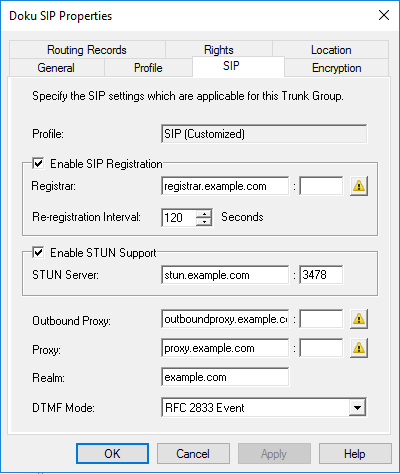13.1.3 The "SIP" Tab of the SIP Trunk Group

The SIP settings for this trunk group are specified on this tab, dependent on the trunk type. You can allow both SIP registration and STUN support here, and set the corresponding parameters. The default setting occurs in the profile selected on the "Profile" tab.
The profile that was selected on the "Profile" tab is displayed here for information. If you change settings of a predefined profile, the profile will be saved as a customized profile.
Activate SIP registration
Activate the checkbox to permit SIP registration.
Define the registrar. REGISTER messages are sent to this address. If no value is entered here, the value configured under proxy will be applied.
The "Re-Registration Interval" defines how often the registration must be updated. A small value will allow you to quickly recognize the loss of the SIP connection to the provider. A high value results in lower network burden in standby.
In the "Port" field you define the port on which the configured registrar receives the registration request.
The port must match the selected transport protocol. Leave the filed empty if you did not receive information on the port by your provider. The port is determined via DNS query.
Activate STUN Support
STUN is a network protocol that recognizes the existence and type of firewalls and NAT routers and takes this information into consideration. It enables the uncomplicated use of devices (e.g. SIP telephones) and programs in networks that should receive information from the Internet.
STUN helps to identify the current public IP address of the line. This is necessary in order for the opposite terminal to correctly address and return your call data.
For more information on the STUN protocol, please see the corresponding RFC standard (RFC 3489).
Activate the checkbox to permit STUN support. See also STUN.
A STUN server can be used to identify the IP address of the line. Supports your provider STUN, so please enter the name or the IP address of the STUN server of your provider and the appropriate port. If you would like to use STUN, although you have not received any STUN server information from the provider, you can use the free STUN server "stunserver.org" with port "3478"..
Configure the general SIP parameters in the lower section:
Outbound Proxy
Some providers have an outbound proxy before the SIP proxy. Configure this parameter according to the settings of your provider.
Proxy
Defines the SIP proxy for outgoing calls.
The SIP proxy server takes over the connection setup to the appropriate subscriber, first checking which SIP registrar the relevant subscriber is logged in with. From this it requests and receives the current IP address of the subscriber, and can thus deliver the call to this address.
Realm
Defines the SIP realm of the provider.
An SIP URI (userId@realm) is derived from the user ID (userId), the configuration of the SIP account, and the realm of the provider (realm). If this field is left blank, the value registrar or proxy will be used.
DTMF method
This mode defines how the provider proceed with the keyboard input of a user during a call (DTMF signaling).
You can choose from a variety of options: